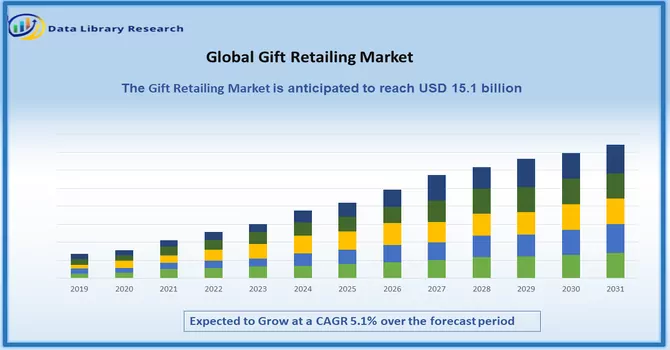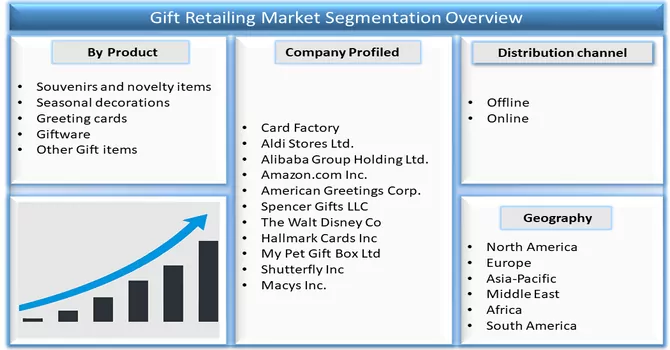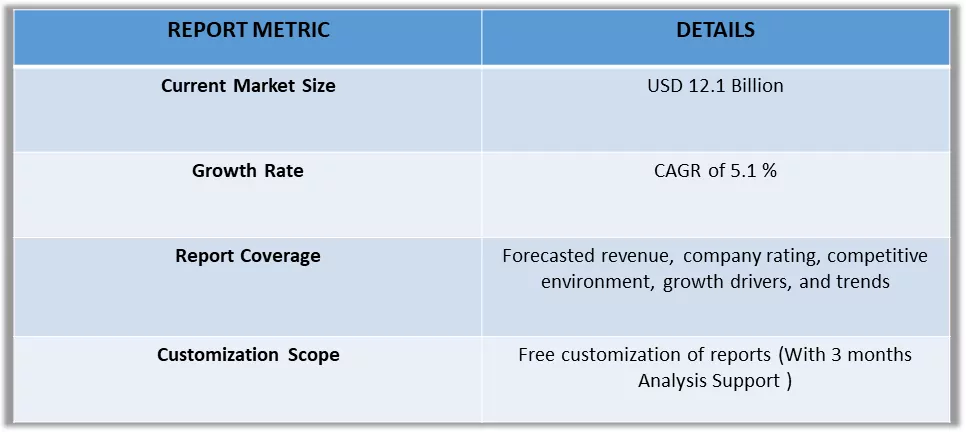The Gifts Retailing Market has generated a revenue of USD 15.1 billion in the current year and is poised to register a CAGR of 5.1% for the forecast period, 2024-2031.

Get Complete Analysis Of The Report- Download Free Sample PDF
The Gift Retailing market plays a pivotal role in the retail sector, offering a diverse range of products designed for various occasions and celebrations. Characterized by an array of items such as personalized gifts, greeting cards, novelty items, and seasonal decorations, this market caters to consumers seeking thoughtful and unique presents for special moments. The sector thrives on the sentimentality associated with gift-giving and the growing consumer inclination toward meaningful and customized expressions of affection.
As a dynamic and evolving segment, Gift Retailing is influenced by changing consumer preferences, seasonal trends, and the constant pursuit of innovative, attractive offerings that resonate with the emotional aspect of gifting. The growth of the Gift Retailing market is propelled by several factors, with one key driver being the continuous demand for personalized and unique gift items. Consumers increasingly seek meaningful and distinctive presents that go beyond conventional choices, driving retailers to offer a wide array of customizable and thoughtfully curated options. Additionally, the rise of e-commerce and online gifting platforms has expanded the market reach, providing consumers with convenient access to a diverse range of gifts. The growing trend of celebrating occasions and expressing sentiments through special, tailor-made gifts contributes significantly to the sustained expansion of the Gift Retailing market.
Market Segmentation: The Gifts Retailing Market is Segmented By Product (Souvenirs and novelty items, Seasonal decorations, Greeting cards, Giftware, and Other Gift items), By Distribution channel (Offline and Online ), and, By Geography (North America, Europe, Asia-Pacific, Middle-East and Africa, and Latin America). The report offers market size and forecasts for the Gifts Retailing Market in value (USD) for all the above segments.

For Detailed Market Segmentation - Download Free Sample PDF
In the evolving landscape of the Gift Retailing market, several trends are shaping consumer preferences and industry dynamics. Personalization continues to be a dominant trend, with customers seeking bespoke and customized gifts that reflect thoughtfulness and uniqueness. Eco-friendly and sustainable gifting options are gaining traction as environmental consciousness grows among consumers. Furthermore, the integration of technology, such as augmented reality (AR) for virtual gifting experiences and online platforms facilitating easy customization, is becoming more prevalent. Social media plays a crucial role, influencing trends and creating a platform for sharing and discovering innovative gift ideas. As the market adapts to changing consumer behaviors, staying attuned to these trends becomes essential for retailers to remain competitive and meet the evolving demands of the Gift Retailing sector.
Market Drivers:
E-Commerce Expansion
The expansion of E-commerce has been a transformative force in the retail landscape, revolutionizing how businesses operate and consumers shop. E-commerce's exponential growth is attributed to its convenience, accessibility, and the ability to reach a global customer base. Consumers can now browse, select, and purchase products from the comfort of their homes, eliminating geographical constraints. This expansion has significantly impacted various industries, from retail to services, and has become a driving force for economic growth. The E-commerce boom has reshaped consumer expectations, fostering a shift towards online transactions and influencing traditional brick-and-mortar businesses to adapt to the digital era.
Rising occasion based Gifting
The trend of rising occasion-based gifting has emerged as a significant driver in the gift retailing market. Consumers increasingly seek meaningful and personalized gifts to celebrate special occasions such as birthdays, anniversaries, and holidays. This shift reflects a desire for more thoughtful and tailored presents that resonate with the recipient's preferences and interests. Gift retailers are adapting to this trend by offering a diverse range of curated products and customizable options, catering to the demand for unique and memorable gifts. As occasion-based gifting gains prominence, it not only enhances the emotional value of the exchange but also contributes to the overall growth and dynamism of the gift retailing industry.
Market Restraints:
Market restraints in the gift retailing industry are influenced by factors such as economic uncertainties, fluctuating consumer spending patterns, and external events that impact celebratory occasions. Economic downturns can lead to reduced disposable income, affecting consumers' willingness to spend on non-essential items like gifts. Additionally, external factors, such as the global pandemic, may disrupt traditional celebrations and gatherings, impacting the demand for gifts. Furthermore, the challenge of predicting and adapting to rapidly changing consumer preferences poses a restraint, as retailers need to constantly innovate and align their offerings with evolving trends. Overcoming these challenges requires flexibility, strategic planning, and a deep understanding of the market dynamics to navigate the complexities of the gift retailing landscape.
The COVID-19 pandemic has significantly impacted the gift retailing market, reshaping consumer behaviors and retail strategies. With lockdowns, social distancing measures, and economic uncertainties, traditional shopping patterns were disrupted, leading to a surge in online gift purchases. E-commerce gained prominence as consumers sought convenient and contactless shopping experiences. The pandemic also influenced the types of gifts in demand, with a growing emphasis on personalized and practical items. The limitations on large gatherings and events impacted the sales of occasion-specific gifts, while home-centric gifts and virtual experiences gained traction. Supply chain disruptions and logistic challenges added complexity to operations. As the world adapts to the new normal, the gift retailing industry continues to navigate the evolving landscape, incorporating digital strategies and addressing changing consumer preferences.
Segmental Analysis:
Souvenirs and novelty items Segment is Expected to Witness Significant Growth Over the Forecast Period
The souvenirs and novelty items market in retailing offers a wide range of products catering to tourists, gift-givers, and collectors. This market includes traditional souvenirs like keychains, magnets, and postcards, as well as unique and customizable items such as personalized gifts and themed merchandise. The market is driven by tourism trends, cultural events, and consumer preferences for unique and memorable gifts. Retailers in this market often focus on creating engaging shopping experiences and offering a diverse product range to appeal to a broad customer base. As the demand for experiential and personalized gifts continues to grow, the souvenirs and novelty items market presents opportunities for retailers to innovate and expand their offerings.
Offline Segment is Expected to Witness Significant Growth Over the Forecast Period
In the gift retailing market, the offline segment plays a crucial role in providing a tangible shopping experience for customers. Offline stores offer a wide range of gift options, from traditional to unique and personalized items, allowing customers to browse and select gifts in person. These stores often focus on creating attractive displays, providing excellent customer service, and offering a unique shopping environment to attract customers. Despite the growth of online shopping, the offline segment remains popular due to the tactile and immediate nature of gift-buying, making it an essential component of the overall gift retailing market.
North America Region is Expected to Witness Significant Growth Over the Forecast Period
In the North American region, the gift retailing market is a vibrant and dynamic sector that caters to a wide range of consumer preferences and occasions. North America's gift retailing market includes a diverse range of products, from traditional gifts such as flowers, chocolates, and greeting cards to unique and personalized items. The region's strong culture of gift-giving, coupled with a robust economy and high consumer spending, makes it a lucrative market for retailers. Additionally, the rise of e-commerce has transformed the gift retailing landscape, with online retailers offering convenience and a wide selection of products. Despite the growth of online shopping, brick-and-mortar stores remain popular in North America, providing a tactile and personalized shopping experience for customers. Overall, the North American gift retailing market is characterized by its diversity, innovation, and strong consumer demand.

Get Complete Analysis Of The Report- Download Free Sample PDF
The analyzed market exhibits a high degree of fragmentation, primarily attributable to the presence of numerous players operating on both a global and regional scale. The competitive landscape is characterized by a diverse array of companies, each contributing to the overall market dynamics. This fragmentation arises from the existence of specialized solution providers, established industry players, and emerging entrants, all vying for market share. The diversity in market participants is underscored by the adoption of various strategies aimed at expanding the company presence. On a global scale, companies within the studied market are strategically positioning themselves through aggressive expansion initiatives. This often involves entering new geographical regions, targeting untapped markets, and establishing a robust global footprint. The pursuit of global expansion is driven by the recognition of diverse market opportunities and the desire to capitalize on emerging trends and demands across different regions. Simultaneously, at the regional level, companies are tailoring their approaches to align with local market dynamics. Regional players are leveraging their understanding of specific market nuances, regulatory environments, and consumer preferences to gain a competitive edge. This regional focus allows companies to cater to the unique needs of local clientele, fostering stronger market penetration. To navigate the complexities of the fragmented market, companies are implementing a range of strategies. These strategies include investments in research and development to stay at the forefront of technological advancements, mergers and acquisitions to consolidate market share, strategic partnerships for synergies, and innovation to differentiate products and services. The adoption of such multifaceted strategies reflects the competitive nature of the market, with participants continually seeking avenues for growth and sustainability. In essence, the high fragmentation in the studied market not only signifies the diversity of players but also underscores the dynamism and competitiveness that drive ongoing strategic maneuvers. As companies explore various avenues for expansion, the market continues to evolve, presenting both challenges and opportunities for industry stakeholders.
Some of the key market players are:
Recent Development:
1) In May 2023, Card Factory reveals its ambitious plans for global expansion, targeting seven international markets. The company takes a strategic step by partnering with Liwa Trading Enterprises, a prominent entity based in the Middle East, which will serve as its exclusive franchise partner in the region, facilitating Card Factory's entry into new territories.
2) In April 2023, Hallmark secures the continuation of its enduring licensing agreement with the iconic Peanuts brand. The renewal, spanning five years, underscores Hallmark's commitment to producing a diverse range of beloved Peanuts products. This includes not only the hallmark greeting cards but also an array of gifts and the cherished Hallmark Keepsake Ornaments, showcasing the enduring popularity of this timeless collaboration.
Q1. What is the current Gift Retailing Market size?
As per Data Library Research the Gifts Retailing Market has generated a revenue of USD 15.1 billion in the current year.
Q2. At what CAGR is the Gift Retailing Market projected to grow within the forecast period?
Gift Retailing Market is poised to register a CAGR of 5.1% for the forecast period.
Q3. What are the Growth Drivers of the Gift Retailing Market?
E-Commerce Expansion and Rising occasion based Gifting are the Growth Drivers of the Gift Retailing Market.
Q4. Which Region is expected to hold the highest Market share?
North America region is expected to hold the highest Market share.
Data Library Research are conducted by industry experts who offer insight on industry structure, market segmentations technology assessment and competitive landscape (CL), and penetration, as well as on emerging trends. Their analysis is based on primary interviews (~ 80%) and secondary research (~ 20%) as well as years of professional expertise in their respective industries. Adding to this, by analysing historical trends and current market positions, our analysts predict where the market will be headed for the next five years. Furthermore, the varying trends of segment & categories geographically presented are also studied and the estimated based on the primary & secondary research.
In this particular report from the supply side Data Library Research has conducted primary surveys (interviews) with the key level executives (VP, CEO’s, Marketing Director, Business Development Manager and SOFT) of the companies that active & prominent as well as the midsized organization
FIGURE 1: DLR RESEARH PROCESS

Extensive primary research was conducted to gain a deeper insight of the market and industry performance. The analysis is based on both primary and secondary research as well as years of professional expertise in the respective industries.
In addition to analysing current and historical trends, our analysts predict where the market is headed over the next five years.
It varies by segment for these categories geographically presented in the list of market tables. Speaking about this particular report we have conducted primary surveys (interviews) with the key level executives (VP, CEO’s, Marketing Director, Business Development Manager and many more) of the major players active in the market.
Secondary ResearchSecondary research was mainly used to collect and identify information useful for the extensive, technical, market-oriented, and Friend’s study of the Global Extra Neutral Alcohol. It was also used to obtain key information about major players, market classification and segmentation according to the industry trends, geographical markets, and developments related to the market and technology perspectives. For this study, analysts have gathered information from various credible sources, such as annual reports, sec filings, journals, white papers, SOFT presentations, and company web sites.
Market Size EstimationBoth, top-down and bottom-up approaches were used to estimate and validate the size of the Global market and to estimate the size of various other dependent submarkets in the overall Extra Neutral Alcohol. The key players in the market were identified through secondary research and their market contributions in the respective geographies were determined through primary and secondary research.
Forecast Model
